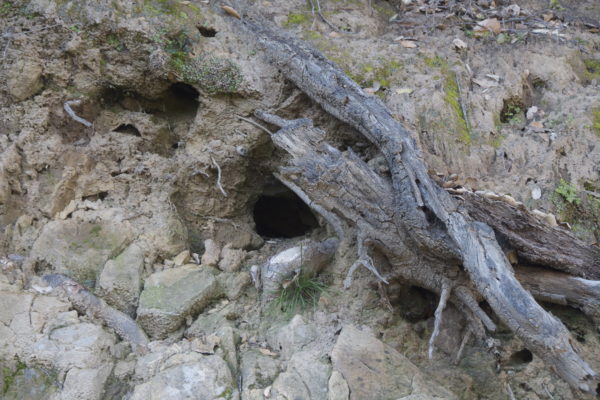
Spring is still a ways away where I live in northern California. The air is fresh; the sunlight brightens the green hills surrounding our mountain. The evenings are becoming just noticeably longer. The opposite coast, from Boston to Maine, saw 30 inches of snow in just a few days. Sensational news stories tell of people stuck in their homes with snow blocking doorways and covering cars.
It might be hard to believe in spring back east, but during my hike in the foothills this evening, the California buckeye trees—always the first to show their green leaves—were magnificently preening against the backdrop of a the late western sun. The Valley oaks will leaf out in a month or so, but until then, the buckeye takes center stage.
In the Greek myth, Persephone is the daughter of Demeter, goddess of the harvest. The beautiful young Persephone is abducted by Hades and taken to his kingdom in the underworld, where he makes her queen. Her mother grieves for her so intensely that nothing grows, introducing the first winter to the world. When Persephone emerges at last, Demeter relents and releases her stranglehold on the earth, letting the tender shoots and tendrils which had been underground unfurl toward the warm sun. The cycle repeats each year.
As for us, by mid-February the urge to shed accumulated winter layers of clothes, pounds, and clutter settle into the collective psyche. Days lengthen and we move outside, toward the grill, or to a patch of weeds. Weeding is therapeutic. Digging the damp dirt, just deep enough to feel the fragile weed roots and gently shaking off the dirt clumps while careful not to disturb those humble tillers, the earthworms, reminds us of the inevitability of change. And that while frost covers the earth, life continues to work underground, below the surface of what is seen. Like Persephone, we emerge from winter to notice the results of underground happenings.
Psychotherapy Provides a Safe Place to Grow into Wholeness and Fullness
When people enter psychotherapy, they are encumbered with layers of accumulated mud. It takes many forms—secrets, sadness, and shame—but alongside the difficulties that motivate people to seek counseling, there is a drive to be whole. It’s manifested in the desire to take care of yourself by reaching out beyond your circle of family and friends to move forward in life, to find a neutral, safe place to explore where you’ve been and who you’ve come to be.
Taking the step to make a call, to schedule an appointment, and to find a way to pay for therapy is a beginning. When new clients arrive in my waiting room, it is with mixed emotions—fear and dread certainly, but also excitement because they have taken the initiative to shake off the dirt and move toward the growth that will surely bring healing. The first appointment brings relief co-mingled with excitement about the prospect of change.
These hints, these intimations that spring is near—just around the corner of the calendar—reconnect us with the ancient knowledge that it is only by going into the dark places within that we can emerge into the fullness of our individual uniqueness. Along with cultivating our gardens, we can cultivate ourselves.

 I just returned from Rhinebeck, NY, where I took an intensive professional training course in Mindfulness-Based Cognitive Therapy (MBCT) for the Prevention of Depression Relapse. The five-day course was developed for health-care professionals who already have experience with mindfulness-based approaches.
I just returned from Rhinebeck, NY, where I took an intensive professional training course in Mindfulness-Based Cognitive Therapy (MBCT) for the Prevention of Depression Relapse. The five-day course was developed for health-care professionals who already have experience with mindfulness-based approaches.



